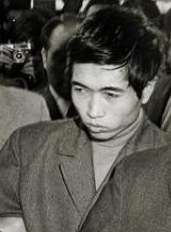Norio Nagayama
Norio Nagayama (永山 則夫, Nagayama Norio, June 27, 1949 – August 1, 1997) was a Japanese spree killer and novelist.
Norio Nagayama | |
|---|---|
 | |
| Born | Norio Nagayama June 27, 1949 Abashiri, Hokkaido, Japan |
| Died | August 1, 1997 (aged 48) Tokyo Detention House in Katsushika, Tokyo, Japan |
| Cause of death | Execution by hanging |
| Criminal penalty | Death penalty |
| Details | |
| Victims | 4 |
Span of crimes | October 11, 1968–November 5, 1968 |
| Country | Japan |
| State(s) | Tokyo, Kyoto, Hokkaidō, Aichi |
Date apprehended | April 7, 1969 |
Biography
Nagayama was born in Abashiri, Hokkaido and grew up in a broken home. He moved to Tokyo in 1965 and, while working in Tokyo's Shibuya district, witnessed the Zama and Shibuya shootings.
Nagayama killed four people with a handgun between October 11 and November 5, 1968. He robbed the last two victims of 16,420 yen. He was arrested on April 7, 1969. When he was arrested, he was 19 years old and was regarded as a minor under Japanese law.
The Tokyo District Court sentenced him to death in 1979, though this was overturned by the Tokyo High Court, which imposed a sentence of life imprisonment in 1981. The Supreme Court of Japan reversed the high court's decision in 1983. This ruling is today considered the landmark decision for application of the death penalty in Japan. The high court subsequently sentenced him to death in 1987, a decision which the Supreme Court upheld in 1990.[1]
In prison, Nagayama wrote many novels and became a public figure. His first published work was Tears of Ignorance (無知の涙, Muchi no Namida) in 1971. In 1983, he was awarded a prize for the novel Wooden Bridge (木橋, Kibashi). The Japanese writing community was uneasy with his success, given his status as a convicted killer. He was rejected by the Japan Writers' Association, but he received a similar recognition in Saarland, Germany in 1996.[2]
His death sentence was contested until his sudden execution on August 1, 1997, just 34 days after the arrest of "Seito Sakakibara", the 14-year-old perpetrator of the Kobe child murders. A foundation to save poor people was established by his will. On August 1, 1997, he was hanged at the Tokyo Detention Center. He made no final statement.[3]
A 1969 documentary by Japanese New Wave director Masao Adachi tells Nagayama's story through biographical information in a voiceover narrated by the director himself. Instead of editing archival footage or staging scenes with actors, Adachi employs an observational approach, filming the places pertinent to Nagayama’s life (including where his spree took place) in order to express the influence that environments have on politics, social standing/class, and psychology.[4]
Victims
- Masanori Nakamura (中村 公紀, Nakamura Masanori)
- Tomejirō Katsumi (勝見 留次郎, Katsumi Tomejirō)
- Tetsuhiko Saitō (斎藤 哲彦, Saitō Tetsuhiko)
- Masaaki Itō (伊藤 正明, Itō Masaaki)
Works
- Muchi no Namida (無知の涙, 1971)
- Ai ka Mu ka (愛か無か, 1973)
- Kibashi (木橋, 1984)
- Soren no Tabigeinin (ソ連の旅芸人, 1986)
- Sutego Gokko (捨て子ごっこ, 1987)
- Shikei no Namida (死刑の涙, 1988)
- Nazeka Umi (なぜか 海, 1989)
- Isui (異水, 1990)
- Hana (華, 1997)
See also
- Akiyoshi Umekawa
- Kiyotaka Katsuta
- Live Today, Die Tomorrow! — a film based on his life.
- A.K.A. Serial Killer - Documentary film
References
- Weisman, Steven R. (1990-04-26). "Death Sentence Fuels Japan's Soul-Searching". The New York Times. Retrieved 2008-06-24.
- "Muchi no Namida" (in German). Retrieved 2008-06-24.
- "Killer's legacy builds bridges". The Japan Times. 2002-07-23. Retrieved 2008-06-24.
- de Luca, Tiago (2015). Slow Cinema. Edinburgh: Edinburgh University Press. p. 261. ISBN 978-0-7486-9605-5.
External links
- In Secrecy, Japan Hangs a Best-Selling Author, a Killer of 4 New York Times, August 7, 1997
- 10 years after hanging, killer still offers lessons to be learned The Japan Times, August 1, 2007
- (in Japanese) Norio Nagayama
- A.K.A Serial Killer, accessed July 17, 2017.